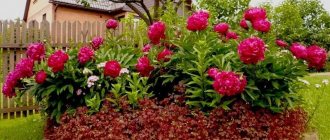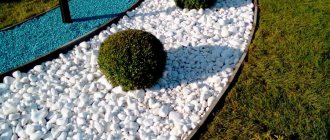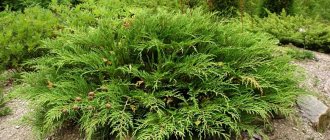The coming winter is an important time for flower growers on our forum. Users of our portal study thick books on floristry and landscape design, draw mixborder schemes, discuss them with their accomplices and redraw them. It's really difficult to create a real mixborder. As a forum member with the nickname Grandma Irisha noted, “all last winter I read, looked at beautiful pictures of landscapers, - so what? You go to your site with that piece of paper with the drawings and a shovel... nothing emerges. All that remains is to plant where your left foot whispers to your right ear.”
What is a mixborder
Mixborder is a popular element of landscape design
Translated from English, mixborder means “mixed border”. This is a complex flower garden, which is created from plants planted in multi-row and multi-tiered ways. A flowerbed always consists of many crops that differ in appearance and budding period. A distinctive feature of this element of the site is its asymmetrical shape, as well as long and continuous flowering.
Mixborder is widely used in landscape design. This type of flower bed can be used to decorate fences and structures, as well as for zoning a garden. Creating a mixed flower garden is not an easy task. It is required to have a good knowledge of the growing season characteristics of the plants used, to select the right varieties and to form an overall composition so that it looks advantageous from any angle.
The overall width of the mixborder is determined by the tallest plant in it. It should not exceed its height by more than 2 times.
Suitable plant species
Mixborders should be formed using annual and perennial specimens. Low conifers or shrubs can be added to some compositions.
It is not recommended to use fast-growing plants with a strong root system, since such specimens can completely displace neighboring flowers.
Perennial
Most often, the basis of the composition consists of perennials. The following specimens have similar requirements for soil composition, lighting and watering:
- Geranium Endressa. This plant is characterized by long flowering, winter hardiness and beautiful dark green foliage.
- The cuff is soft. This specimen looks quite decorative thanks to its numerous yellow flowers and large leaves.
- Bloodroot. The plant stands out thanks to the attractive flowers that appear in mid-summer.
- Coreopsis. The advantages of this flower are luxurious and long-lasting flowering.
- Decorative wormwood. The plant looks unusual thanks to its lacy leaves.
- Boxwood. Beautiful foliage and ease of care are the main advantages of this specimen.
- Verbena. The peculiarity of this plant is that it can bloom until the onset of severe frost.
- Clematis. This specimen has velvety pink and blue flowers.
- Lofanta. The features of this plant are its spectacular appearance and splendor.
Low-growing perennial plants that bloom in spring and have beautiful foliage are recommended to be planted in the foreground.
Video: review of popular perennials
Annuals
Annual plants perfectly complement the composition. Flower growers should take a closer look at the following specimens:
- petunias;
- pelargoniums;
- begonias;
- poppies are sleeping pills;
- asters;
- marigold;
- ageratums;
- sunflowers;
- Iberis;
- violets;
- cornflowers.
Photo: attractive annual specimens
Soporific poppy is distinguished by large luxurious flowers
Violets bloom throughout the summer
Asters bloom at the end of the summer, when most other annuals have already faded.
Pelargoniums are decorative and winter hardy
Conifers
During the flowering of perennials and annuals, coniferous plants become an excellent background for flowers and ornamental shrubs, and in winter they attract attention. Among the most popular specimens, it is worth highlighting the following types and varieties:
- Scots pine Fastigiata;
- Lawson cypress;
- Korean fir;
- mountain pine Pumilo;
- juniper;
- weeping larch.
Photo: decorative varieties of conifers
Lawson's cypress is a showy tree with round cones
Fastigiata pine has unusual blue needles
Korean fir has silver needles, and its cones have an unusual purple hue.
Weeping larch looks very unusual and brings a special charm to the composition
Shrubs
Among the shrubs for mixborders, it is recommended to choose flowering specimens that are distinguished by long-lasting flowering and a compact crown. The following plants will look good in a flower garden:
- rhododendron;
- magnolia;
- barberry;
- cotoneaster
Photo: beautiful views of shrubs
Rhododendron does not bloom for long, but is distinguished by luxurious inflorescences
Decorative foliage of barberry stands out against the background of other plantings
A special feature of cotoneaster is its bright red berries, which can decorate any composition.
Magnolia is a flowering shrub with large flowers of various shades.
Varieties
There are different types of mixborders. There are no universal solutions in landscape design; each element in the garden is selected taking into account the general style of the site, the characteristics of the soil and climate, and geographical subtleties.
Shrubby
A mixed flower garden of shrubs needs regular shaping
Recommended for decorating fences and buildings on the site. The emphasis in this composition is shrubs with different flowering periods, as well as tall flowering crops. Within this species, coniferous mixborders are distinguished separately. Their advantage is ease of maintenance and unpretentiousness to external conditions.
English
A mix border made in the English style is the beauty and clarity of straight lines
It is distinguished by simple plants and strict design. The decorative effect of such a flower garden is achieved by clear lines and restraint of colors. Suitable for designing garden paths, decorating terraces and gazebos.
Rustic
A rustic flowerbed will decorate any garden plot
The specificity of this species is the lush flowering of plants characteristic of the local climate. High-quality and regular care is required, otherwise the village mixborder quickly becomes unkempt. It is for this reason that herbaceous crops should be planted with great care.
Vegetable or garden
A flowerbed can even be created from seasonal vegetables and herbs
The most practical type of mixborder. Various seasonal vegetable crops with different growing seasons are used as plants. The harvest can be harvested as it ripens. It is important to ensure the correct formation, preventing the growth and reduction of green mass. This is the optimal solution for a garden where functionality and beauty are important.
Classic English
The traditional mixborder combines English stiffness, strict lines and natural freedom. Often these are mixborders with roses and peonies. On a single territory there are low-growing coniferous trees, flowering and green shrubs, wildflowers and cereals. Boxwood and thuja here successfully coexist with dahlias and phlox. The crowns of trees and bushes must be trimmed. Curly tops are welcome.
Mixborder design schemes
When creating a scheme for a mixed flower garden, it is important to take into account the row arrangement of plants. The first level should contain low-growing (border) crops, which are required only to emphasize the overall style. The second row is always the densest and most voluminous plantings, producing a lot of greenery and buds. For the last row and framing, shrubs and low-growing trees are best suited.
Choosing a color scheme is the most difficult step when creating a mixborder. It is important not to overdo it, to achieve a harmonious ratio of all shades. It is recommended to use no more than 4–5 colors; when choosing contrast and compatibility, use a chromatic circle.
Schemes of mixborders in the photo
A round flower garden is the optimal solution for the central part of the site
An elongated mixborder is suitable for zoning a garden area
An example of a simple mixborder in a rustic style
Complex flower garden of different types of plants
Mixborder for large areas
Color solutions
When planning a mixborder, after determining the shape and style, it is important to choose the color scheme of the composition. It can be based on a combination of contrasts or, conversely, on complementing some shades with others. The latter option looks more elegant and noble, but requires a particularly careful selection of plant material.
Multicolor compositions are suitable mainly for large areas, since their beauty can only be fully appreciated from a certain distance.
A mixborder designed in pastel colors is considered almost universal, harmonizing with any environment. Unobtrusive combinations of soft pink, light lilac and yellowish shades, framed by silvery greenery, will enliven the landscape and, attracting admiring glances, create a special romantic atmosphere.
Do-it-yourself mixborder planning and design
A mixed flower bed is suitable for decorating garden paths
A mixed flower garden can be created almost anywhere in the garden. Mixborders are most often formed near the boundaries of the site, along the paths or walls of the house. Tall plants are better suited for landscaping fences and structures, and low-growing ones for placement in the center of the garden, as they are clearly visible from all sides. Paths, borders, stone elements and garden sculptures are used to create clear lines. They make the flowerbed complete and well-groomed.
It is important to consider the compatibility of plants. All crops for planting in the same flower bed must tolerate light and shadow equally, this allows for high growth rates and uniform flowering. It is recommended to choose varieties adapted to the climate in the region to avoid problems due to lower temperatures. In addition, it is necessary to take into account the growing season and flowering period. All plants should bud in rows or bloom at the same time and wither at the same rate.
Recent Entries
Lilac perennials that are beautiful, compact and do not crowd out other plants Why when buying seedlings you should not take the sellers’ word for it and how to determine the age of the plant using 3 signs Tomato seedlings have turned purple or whitish: why the color has changed and how to save the plants
Selection of filling
Plants must be selected according to the following parameters:
- height;
- decorative;
- flowering period;
- specifics of “service”.
For example, when creating a mixborder of perennials, clematis and a number of evergreen conifers are placed in the background, barberry bushes and daylilies are in the middle, and cereals and meadow flowers are in the foreground.
A vegetable flower garden is appropriate along the paths. Lettuce, herbs, cabbage, peppers are in perfect harmony with cultivated varieties of flowering plants.
Helpful care tips
Mixborder needs regular watering, fertilizing and pruning
With a competent approach to choosing plants for a mixborder and its location on the site, problems with care do not arise. The main task is to maintain decorativeness throughout the season. This requires:
- observe regular watering, spray the leaves during dry periods;
- apply mineral fertilizers at least 2 times a summer to enhance flowering and growth;
- remove weeds, loosen the soil;
- trim all overgrown, dry and deformed shoots, and also shape the bushes in autumn and spring.
The use of fungicides and insecticides is only required when characteristic signs of infestation are detected. For preventive purposes, treatment is usually not carried out.
How to care
Mixborders, like any other type of flower garden, require care.
Even if you choose the most unpretentious and unpretentious plants, there is a minimum without which it will lose its decorative effect:
Flowers need regular watering. It is better twice a day - morning and evening, at least 10 liters of water if perennials are planted.
In order for the “filling” of the mixborder to feel good, it is necessary to periodically loosen and fertilize the soil.
It is also worth remembering the need for weeding. It is better to remove weeds manually - the use of herbicides will harm the main crops.
Prevention against pests will help reduce the likelihood of diseases.
Starting in spring, you need to monitor and remove dry shoots and dried flowers.
To summarize, we note that any gardener can create a beautiful mixborder. All you need is desire, free time, strength and money.
Reviews and advice from experienced flower growers
Mixborder easily becomes the main composition of a garden in any style
In Russia, mixborders are just becoming popular, and it is not so easy for beginners to master this element of landscape design. When creating mixed flower beds, experienced gardeners advise carefully choosing plants and not forgetting about the style as a whole. It should be combined with the overall design of the site. For example, a flower bed decorated with simple rustic flowers is not suitable for an ascetic Japanese garden. At the same time, there is no need to be afraid to experiment: this is the only way to create a mixborder that you will like.
There are no hard and fast rules when creating a composition. It is important to rely on the color scheme and use your imagination to achieve visual volume and harmony in the flower garden.
My husband and I are big fans of the English style, including mixborders. So far we have 4 of them laid on our site. Here is the main one. Founded in 2013. During its existence, many flowers have been lost. The soil there turned out to be unsuitable for crops such as sage. He's wet. But astilbes, hostas and daylilies really like the proximity of viburnums, spirea, mackerel and cherries. ... Now I’m already coming to the conclusion that it is necessary to plan and draw! No matter how crazy it may seem. This will save you from many, many transplants.
Based on the agricultural technology of the mixborder, I can say that 1) weeding is easier, because the plants are tightly packed and the weeds have a very hard time; 2) the soil becomes very compacted, again due to the density of plantings; 3) very dry soil, because many plants evaporate; 4) in the spring I step on the same rake: I plant a bunch of everything, because it seems that there is still room, then everything blooms, and half of the plantings end up in deep shade, completely clogged. For myself, I conclude that it is necessary to add medium and low flowering ones. Including annuals.
elsa30
https://www.tomat-pomidor.com/forums/topic/3796-%D0%BC%D0%B8%D0%BA%D1%81%D0%B1%D0%BE%D1%80%D0%B4 %D0%B5%D1%80/
And I really like hosts. They don't give me any problems and look great all summer long. I also saw a diagram of how to plant it beautifully. Now I want to do the same.
Elena
https://www.tomat-pomidor.com/forums/topic/3796-%D0%BC%D0%B8%D0%BA%D1%81%D0%B1%D0%BE%D1%80%D0%B4 %D0%B5%D1%80/
In my mixborder, hostas can be called backbone, beautiful until autumn. You just need to plant at least a meter apart between them, or use a shovel to periodically reduce their diameter.
Nellya
https://www.tomat-pomidor.com/forums/topic/3796-%D0%BC%D0%B8%D0%BA%D1%81%D0%B1%D0%BE%D1%80%D0%B4 %D0%B5%D1%80/
Create strong boundaries
Thin strips less than 50 cm wide will create a small hedge. A shrub or row of neat perennials, properly positioned, will look like soldiers on parade. However, in beds and borders wider than two meters, you can place multi-layered mixed plantings with shrubs and more natural transitions of perennials and grasses.
Some designs, particularly naturalistic plantings, require a lot of space to create the desired effect.
Top line
There is a background, and there is the top line of the composition itself. She must be beautiful. This is a whimsical but balanced line, without shifting the center of gravity to the left or right. At the same time, it should not be boring and monotonous.
Avoid long, flat areas. Sometimes you can see beautiful mixborders of low-growing trees, shrubs, tall and low perennials.
At the same time, the top line of the fence is perfectly straight and depressingly monotonous. As soon as the plant crosses this line, the mood will change to a more lively one.
Along the path
Very often, flower beds are located along the borders of a summer cottage or along paths. In such a situation, the outline of the flower arrangement should be highlighted using path tiles or other suitable material. You can use tree stumps, chocks and cobblestones.
Small flower beds are always decorated with long-growing plants (polygonum, echinacea). An excellent addition to the composition will be decorative foliage plants (cineraria, wormwood), shimmering with silvery light.
Designers recommend the use of perennial cereal crops, which add yellow shades to the flower garden (from yellow-brown to bright bronze): feather grass, ozhika, pearl barley, etc.
Scheme of the flower bed along the path:
Mixborder located along the house (in the photo below we use: Actinidia kolomikta variety Male, Quick Fire hydrangea, Little Rocket buzulnik, and two types of hosts: Patriot and Sagae):
Along the stairs:
Corner flower beds
On every site there is a not very attractive corner in the corner of the fence or near the compost heap, which I would like to make more attractive and pleasing to the eye. As a solution to this problem, corner mixborders are suitable, which will add originality to the design of the area and cover problem areas.
Schemes of a corner flower bed:
Designations for the last diagram: 1 - Woolly chistets; 2 - Ashy fescue; 3 - Veronica Kolosovaya; 4 - Golden cinquefoil; 5 - Red geranium; 6 - Lobelia perennial; 7 - Red Quinoa; 8 - Molinia; 9 - Switchgrass; 10 - Asters; 11 - Tithonia roundifolia; 12 - Peach bell; 13 - Phlox paniculata; 14 - Coreopsis large-chased.
Example of a corner composition:











